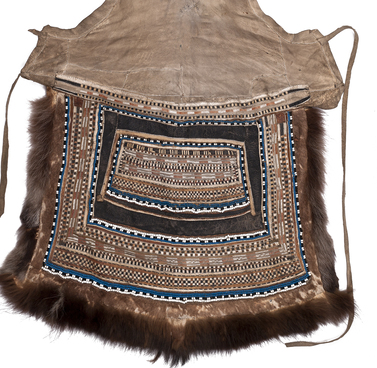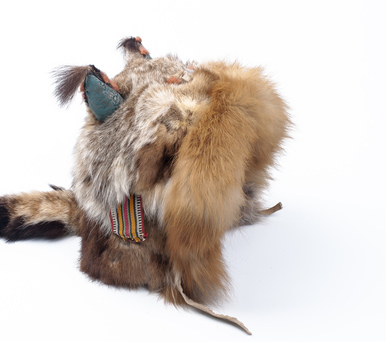The traditional clothing of the Even people was close to that of the Evenki, which is why it is referred to as “Tungusic” in the literature. The basic set of clothes included a caftan, apron, belt, unty boots, hat and mittens. Clothing was made of reindeer and mountain sheep fur as well as deerskin.
All parts of the garment were sewn together with threads made of deer or elk sinews. The main element of the ethnic costume — both female and male — was an open caftan of fitted silhouette with sewn-into sleeves (a cut in which the parts are joined at the place of natural transition of the shoulder to the arm). The caftan was always tight: its flaps did not come together, but were wrapped with deerskin suede straps.
The absence of fasteners allowed the Even people who were nomadic reindeer herders in the taiga and who spent most of their lives in the saddle to easily mount a reindeer. Depending on the season, the caftan was made of both fall and summer, thin hides with short-pile and winter skins.
There was no principal difference in terms of cut between women’s and men’s caftans. Women’s clothing was distinguished mainly by the abundance of jewelry and decorative patterns. There were several types of women’s upper shoulder clothing: naimi — a summer deerskin caftan, dudyka — a winter coat with fur inside, muka — a caftan with fur outside.
According to some researchers, the dudyka (dudik) coat, an undercoat that functioned as a shirt, is the most ancient element of clothing. It was characterized by a primitive cut: the skin from the upper part of the front legs of a deer, which was removed unopened, served as sleeves.
Travelers compared the Tungus caftan to a Spanish camisole. All clothes were abundantly decorated with colored beads, embroidered with white deer hair and silk threads, inlaid with pieces of fur, strips of leather and cloth of different colors, covered with woven straps, appliquéd with pieces of colored fabric and metal plaques.
The edgings of the side,
hem, cuffs and main seams of the garment, various welts and pipings emphasized
the architectonics of the garment and created the texture. The traditional
decorative patterns in the Even women’s art were mainly reduced to the simplest
geometric shapes.





